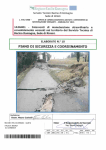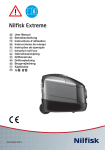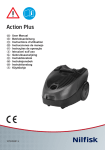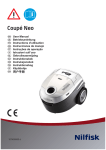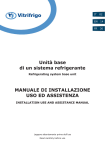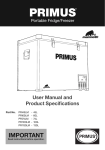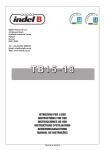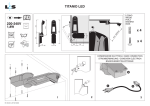Download Manuale di Istruzioni Instruction manual CR165 CR219 CR271
Transcript
Manuale di Istruzioni Instruction manual CR165 CR219 CR271 Ver. 1.0 Manuale d’uso – User’s Manual CG 030609 Ver 1.0 Manuale d’uso – User’s Manual I refrigeratori Isotherm sono progettati per garantire un corretto funzionamento anche in difficili condizioni ambientali/marine, eccellendo nelle caratteristiche più importanti per la nautica: affidabilità e ridotto consumo energetico. Dotati di sistema di raffreddamento a tenuta ermetica, garantiscono il minor consumo di energia possibile ed una manutenzione ridotta. Tutti i modelli sono estremamente facili da installare. Possono sopportare uno sbandamento laterale di 30°. Per garantire il funzionamento più efficiente possibile del refrigeratore Isotherm, attenersi alle seguenti istruzioni: • • • • • Evitare di aprire le porte del refrigeratore se non necessario. Assicurare una buona ventilazione del compressore e condensatore. Controllare le buone condizioni del sistema elettrico. Ispezionare batterie e livelli di carica regolarmente. Avviare sempre il motore con un gruppo batterie separato. Seguire attentamente le istruzioni relative al cablaggio elettrico e vano fusibili. Mantenere pulito l’interno del frigo/freezer. Lasciare socchiuse le porte del frigo/freezer quando l’imbarcazione non è utilizzato per lunghi periodi. Istruzioni per la Sicurezza Quando si è connessi alla rete elettrica della banchina, assicurarsi che il generatore di corrente sia predisposto con un salvavita. Attenzione! Non lasciare mai cavi scoperti inseriti nell’alimentazione elettrica. Attenzione! Mai collegare direttamente al refrigeratore il caricabatterie. I recenti carica batterie contengono, in aggiunta all’acido, un gas esplosivo. Attenzione! Mai coprire le aperture di ventilazione dell’unità compressore. Non disperdere il refrigerante in aria. Sensore Batteria Per proteggere le batteria dall’esaurimento totale, un sensore di voltaggio spegnerà automaticamente il compressore ai seguenti livelli: VOLTAGGIO 12V 24V Cut-Out 9.6V 21.3V Cut-In 10.9V 22.7V CG 030609 Ver 1.0 Manuale d’uso – User’s Manual Installazione Quasi tutte le imbarcazioni hanno uno specifico spazio destinato all’installazione del frigorifero. Il refrigeratore Isotherm è stato progettato per soddisfare le normali dimensioni di installazione. Il compressore deve rimanere in posizione verticale ma opererà anche con una oscillazione di 30° e più per periodi brevi. I requisiti minimi obbligatori per l’installazione a bordo sono: • 2 cm di luce sopra il frigorifero (fra il frigo e la linea del mobilio); • Lateralmente, le pareti del frigorifero possono essere messe a contatto con il mobilio. Installazione consigliata: Al fine di massimizzare la performance e l’efficienza del frigo (funzionamento ottimale e risparmio energetico), consigliamo di aggiungere al requisito minimo di 2cm di luce nella parte superiore, ulteriori 2cm di luce per ogni lato. Questo perché l’evaporatore è schiumato nei lati del refrigeratore e applicando qualsiasi staffa o supporto si rischia di forare lo stesso causando la fuoriuscita del gas refrigerante e danneggiando in modo irreparabile il prodotto. Fissare il prodotto alla base dello stesso e nella parte superiore con le apposite staffe (fornite) come da figure 3 e 4: Fig.3 E’ importante non forare i lati del frigorifero dove è presente l’etichetta gialla di avvertenza (Fig.1,Fig.2). Fig.4 Fig.1 Importante: non rimuovere mai i piedini di supporto. Ventilazione E’ estremamente importante che l’unità compressore sia adeguatamente areata e che l’afflusso d’aria fresca sia sempre garantito. La naturale areazione dal basso verso l’alto può essere incrementata con delle aperture di ventilazione in corrispondenza del retro del refrigeratore. Fig.2 CG 030609 Ver 1.0 Manuale d’uso – User’s Manual Sostituzione Lampadina Connessioni e cablaggio elettrico Per la connessione del refrigeratore seguire le seguenti avvertenze: • Usare sempre cavi con un’adeguata sezione, Di seguito una tabella con le sezioni minime: Sezione mm2 Diametro 2.5 4 6 12 10 10 Lunghezza max cavo 12V mt/ft 2.5/8 4/13 6/19 Per sostituire la lampadina impostare il termostato in posizione 0 (OFF, luce spenta), fare pressione sulla levetta del coperchio trasparente (Fig.6) verso l’esterno come indicato in Fig.7. L’attacco della lampadina è di tipo E14, 12V/24V, Max 15W. Lunghezza max cavo 24V mt/ft 5/16 8/26 12/39 • Connettere sempre il refrigeratore direttamente alla batteria o all’interruttore principale della batteria. Se connesso tramite il pannello di controllo principale dell’imbarcazione, o altro, può causare un abbassamento di tensione che va preso in considerazione quando si calcola la sezione dei cablaggi. Il sistema deve avere un fusibile da 15A per 12V o da 7,5A per 24V. Se è previsto un interruttore deve essere almeno 20A per evitare perdite di tensione. • Collegare il cavo rosso (+) al polo positivo ed il cavo nero (-) al polo negativo. • Non collegare mai direttamente il refrigeratore al carica batterie. Questo potrebbe essere collegato al pacco batterie. Regolazione della temperatura Il refrigeratore è dotato di un termostato a manopola con interruttore ON/OFF integrato. Ruotando la manopola a fine scala si avvertirà un click che identifica lo spegnimento dell’apparecchio. Fig.6 Fig.7 Sbrinamento Lo scongelamento va eseguito quando lo strato di ghiaccio raggiunge i 3-4 mm di spessore. Ruotare il termostato in posizione OFF (fine scala). Conservare gli alimenti ed i liquidi al fresco durante il processo di scongelamento. Non utilizzare spatole di metallo per rimuovere lo strato di ghiaccio. Non riaccendere fino a che il frigorifero sia scongelato asciutto e pulito. Pulire il tubo di scarico condensa e controllare che esso non sia ostruito. 0 = Posizione OFF. L’apparecchio è spento 1 = Posizione acceso, minima refrigerazione 7 = Posizione acceso, massima refrigerazione Fig.5 CG 030609 Ver 1.0 Manuale d’uso – User’s Manual Manutenzione I refrigeratori Isotherm hanno un sistema di raffreddamento a chiusura ermetica che non necessita di manutenzione o rabbocchi di fluido refrigerante. Il refrigeratore può essere lasciato sull’imbarcazione durante l’inverno (se la temperatura scende sotto lo 0 il compressore può non avviarsi). La manutenzione, non meno di una volta all’anno, può essere ridotta solamente alla pulizia della polvere dal condensatore. Utilizzare una spazzola morbida e non strumenti appuntiti. Lasciare l’interno del refrigeratore pulito e asciutto. Pulire lo scarico condensa e verificare che non sia ostruito. Lasciare le porte del frigo/freezer socchiuse durante il periodo di non utilizzazione dell’apparecchio per consentire un’adeguata ventilazione all’interno dei vani, impostare il termostato a 0 (OFF) per evitare sprechi di corrente causati dall’accensione della lampadina. Drenaggio e Condensa Il refrigeratore Isotherm viene fornito con un tubo di drenaggio direttamente collegato all’apparecchio, Fig.4. Svolgere il tubo di drenaggio e collegarlo ad uno scarico appropriato, Fig.5. Fig.5 Frigo/Congelatore Doppia Porta Isotherm Per i Frigo/Congelatori doppia porta, la priorità è stata data al risparmio energetico. Il consumo è modesto in rapporto al volume ed alla capienza del frigorifero. 1. E’ normale che il compartimento frigo impieghi da 6 a 12 ore per raggiungere la temperatura selezionata, soprattutto se ricolmo di alimenti. 2. Se la temperatura ambiente è molto alta, si otterranno risultati migliori posizionando il termostato ad un punto intermedio (pos.4) piuttosto che selezionando le temperature più basse. INFORMAZIONI TECNICHE Voltaggio Consumo 12V Media Consumo 12V Compressore Refrigerante Fusibile 12/24 Volt 6A (compressore in funzione) 2,3 – 2,5 A Danfoss BD50F R134a, 0,13 Kg 12V – 15A / 24V – 7,5A Fig.4 CG 030609 Ver 1.0 Manuale d’uso – User’s Manual Collegamento Centralina DC 12V/24V CG 030609 Ver 1.0 Manuale d’uso – User’s Manual Difetto Il frigorifero non raffredda. Il compressore non parte. Possibile Causa Alimentazione elettrica assente. Batterie scariche. Termostato danneggiato. Fusibile danneggiato. Centralina elettrica danneggiata. Azione da intraprendere Controllare cablaggio elettrico, cavi e collegamenti. Verificare alimentazione compressore. La luce funziona? Controllare il sistema di ricarica batterie. Controllare termostato, ponte elettrico T-C, se il compressore si avvia il termostato è danneggiato. Se il compressore non si avvia, sostituire centralina elettrica. Il compressore funziona solo ad intervalli di qualche secondo. Alimentazione elettrica insufficiente. Voltaggio troppo basso o perdita di voltaggio all’avvio. Batterie esaurite. Ventola difettosa. Controllare connessioni e cablaggio elettrico, possibilità di ossidazione. Caricare batterie, avviare il motore dell’imbarcazione o ricaricarle tramite allaccio alla banchina. Al momento dell’accensione il voltaggio deve essere >= 11V. Scollegare la ventola, se il compressore si avvia la ventola è difettosa, sostituirla. Il compressore parte ma il frigorifero non raffredda. Mancanza di gas refrigerante. Possibile perdita dei tubi o dell’evaporatore. Tubazioni ostruite. (Queste operazioni vanno eseguite da personale tecnico autorizzato). Controllare con il “cercafughe” eventuali perdite di gas refrigerante. Riparare la possibile perdita. Eseguire il vuoto del sistema e ricaricarlo con l’apposito gas refrigerante (R134a). Il compressore funziona per lunghi periodi ma non raffredda abbastanza. Non adeguata ventilazione del sistema compressore/condensatore. Ventola danneggiata. Accumulo di ghiaccio nel vano freezer. Chiusura delle porte non adeguata. Condensatore bloccato dalla polvere. Aumentare la ventilazione del sistema Compressore/Condensatore. Sostituire la ventola. Eseguire sbrinatura reparto freezer. Controllare la corretta posizione della guarnizione di tenuta delle porte. Rimuovere la polvere dal condensatore. CG 030609 Ver 1.0 Manuale d’uso – User’s Manual CG 030609 Ver 1.0 Manuale d’uso – User’s Manual Isotherm refrigerators are designed to guarantee correct function, even in difficult environmental/marine conditions. They excel in terms of the most important characteristics for the marine environment: reliability and low energy consumption. Equipped with a hermetic seal cooling system, they guarantee the least possible energy consumption and reduced maintenance. All models are very easy to install. They can withstand lateral movement of 30°. To guarantee the most efficient function possible of the Isotherm refrigerator, comply with the following instructions: • • • • • Avoid opening the refrigerator doors if not necessary. Ensure good compressor and condenser ventilation. Check that the electrical system is in good condition. Inspect batteries and charge levels regularly. Always start the engine up with a separate battery unit. Keep to the instructions concerning the electrical wiring and fuse box, closely. Keep the inside of the refrigerator/freezer clean. Leave the refrigerator/freezer doors slightly open when the ship is not in use for long periods of time. Safety instructions When connected up to the quay mains electrics, ensure that the current generator is set up with a trip switch. Warning! Never leave uncovered wires connected to the electrical supply. Warning! Never connect the battery charger to the refrigerator directly. New battery charger contain an explosive gas in addition to the acid. Warning! Never cover the ventilation openings of the compressor unit. Do not dispose of coolant in the air. Battery sensor To protect the battery from running down completely, a voltage sensor will turn the compressor off automatically at the following levels: VOLTAGE 12V 24V Cut-Out 9.6V 21.3V Cut-In 10.9V 22.7V CG 030609 Ver 1.0 Manuale d’uso – User’s Manual Installation Almost all ships have a specific area for refrigerator installation. The Isotherm refrigerator has been designed to comply with normal installation dimensions. The compressor must remain in a vertical position, but will also work for short periods at an oscillation of 30° or more. The minimum compulsory requirements for on board installation are as follows: • 2 cm space above the refrigerator (between the refrigerator and the furniture line); • To the side, the refrigerator walls can be placed in contact with the furniture. Recommended installation: To maximise refrigerator performance and efficiency (optimal function and energy saving), we recommend addition a further 2 cm space on each side, to the minimum requirement of 2 cm above the refrigerator. It is important not to pierce the sides of the refrigerator where the yellow warning label is placed (Fig.1, Fig.2). This is because the evaporator is foamed at the sides of the refrigerator and applying any rod or support risks piercing this, causing refrigerant gas to leak out and irreparably damaging the product. Fix the product at its base and at the top, using the specific rods (supplied) as shown in figures 3 and 4: Fig. 3 Fig. 1 Fig. 4 Important: never remove the support feet. Ventilation It is extremely important that the compressor unit is appropriate aired and that the flow of fresh air is always guaranteed. The natural ventilation from the bottom upwards can be increased with ventilation openings at the level of the refrigerator back. Fig. 2 CG 030609 Ver 1.0 Manuale d’uso – User’s Manual Electrical wiring and connections Replacing the bulb Comply with the following warnings for refrigerator connection: To replace the bulb, set the thermostat to 0 (OFF, light off), apply gentle pressure to the transparent cover lever (Fig. 6), pushing outwards as shown in Fig. 7. The bulb attachment is type E14, 12V/24V, Max 15W. • Always use appropriate section wires. The following table gives the minimum sections: Section mm2 Diamete r 2.5 4 6 12 10 10 Max. wire length 12V mt/ft 2.5/8 4/13 6/19 Max. wire length 24V mt/ft 5/16 8/26 12/39 • Always connect the refrigerator directly to the • • battery or main battery switch. If connected by means of the main boat control panel or other, it may lead to a lowering of voltage that should be considered when calculating wiring section. The system must have a 15A fuse for 12V, or 7.5A for 24V. If a switch is to be used, it must be at least 20A to avoid loss of voltage. Connect the red wire (+) to the positive pole and the black wire (-) to the negative pole. Never connect the refrigerator directly to the battery charger. This could be connected to the battery pack. Temperature regulation The refrigerator is equipped with a thermostat dial and built-in ON/OFF switch. By rotating the dial to the end of the scale, you will hear a click indicating that the appliance has been turned off. Fig.6 Fig.7 Defrost Defrosting should be carried out when the layer of ice is 3-4mm thick. Rotate the thermostat to the OFF position (end of scale). Store foods and liquids in a cool place during defrost. Do not use a metal spatula to remove the layer of ice. Do not turn back on until the refrigerator is fully defrosted, dry and clean. Clean the condensation drainage pipe and check that it is not blocked. 0 = OFF position. The appliance is off 1 = ON position, minimum refrigeration 7 = ON position, maximum refrigeration Fig. 5 CG 030609 Ver 1.0 Manuale d’uso – User’s Manual Maintenance Isotherm refrigerators have a hermetic seal cooling system that requires no maintenance nor topping up of coolant liquid. The refrigerator can be left on board the boat all winter (if the temperature goes below 0, the compressor may not start). Maintenance, no less than once a year, may merely involve cleaning dust from the condenser. Use a soft brush and no sharp tools. Leave the inside of the refrigerator clean and dry. Clean the condensation drain and check that it is not blocked. Leave the refrigerator/freezer doors slightly open when the appliance is not in use, to allow for appropriate ventilation within the units. Set the thermostat to 0 (OFF) to avoid any wastage of current caused by the light being on. Two-door Isotherm refrigerator/freezer For two-door refrigerator/freezers, priority has been given to energy saving. Consumption is very limited compared to refrigerator volume and capacity. 3. It is quite normal for the refrigerator compartment to talk from 6 to 12 hours to reach the temperature selected, particularly if filled with food. 4. If room temperature is very high, better results will be obtained by setting the thermostat to an interim point (pos. 4) rather than selecting a lower temperature. TECHNICAL INFORMATION Drainage and condensation The Isotherm refrigerator is supplied with a drainage pipe directly connected to the appliance, Fig. 4. Unwind the drainage pipe and connect to an appropriate drain, Fig. 5. Voltage Consumption 12V Average consumption 12V Compressor Coolant Fuse 12/24 Volts 6A (compressor operating) 2.3 – 2.5 A Danfoss BD50F R134a, 0.13 Kg 12V – 15A / 24V – 7.5A Fig. 4 Fig. 5 CG 030609 Ver 1.0 Manuale d’uso – User’s Manual Connection Control unit DC 12V/24V CG 030609 Ver 1.0 Manuale d’uso – User’s Manual Problem The refrigerator does not cool down. The compressor does not start. Possible cause No electrical supply. Batteries flat. Thermostat damaged. Fuse damaged. Electrical control unit damaged. Action to be taken Check electrical wiring, wires and connections. Check compressor power. Does the light work? Check the battery recharge system. Check the thermostat, T-C electrical bridge, if the compressor start the thermostat is damaged. If the compressor does not start, replace the electrical control unit. The compressor only works at intervals of a few seconds. Insufficient electrical supply. Voltage too low or loss of voltage at start-up. Batteries flat. Fan faulty. Check connections and electrical wiring, possibility of oxidation. Charge batteries, start up the boat engine or recharge by means of quay connection. Upon start-up the voltage should be <=11V. Disconnect the fan, if the compressor starts up, the fan is faulty, replace it. The compressor starts but the refrigerator does not cool down. Lack of coolant gas. Possible leak from pipes or evaporator. Pipes blocked. (These operations must only be carried out by authorised technical staff). Use the ‘leak searcher’ to check for any leaks of coolant gas. Repair any possible leaks. Empty the system and refill with specific coolant gas (R134a). The compressor works for long periods, but does not cool sufficiently. Insufficient ventilation of the compressor/condenser system. Fan damaged. Accumulation of ice in the freezer compartment. Door closure insufficient. Condenser blocked by dust. Increase ventilation of the compressor/condenser system. Replace the fan. Defrost the freezer compartment. Check correct position of door seal. Remove the dust from the condenser. CG 030609 Ver 1.0 Manuale d’uso – User’s Manual CG 030609 Ver 1.0 Manuale d’uso – User’s Manual GB This appliance is marked according to the European directive 2002/96/EC on Waste Electrical and Electronic Equipment (WEEE). By ensuring this product is disposed of correctly, you will help prevent potential negative consequences for the environment and human health, which could otherwise be caused by inappropriate waste handling of this product. The symbol on the product, or on the documents accompanying the product, indicates that this appliance may not be treated as household waste. Instead it shall be handed over to the applicable collection point for the recycling of electrical and electronic equipment. Disposal must be carried out in accordance with local environmental regulations for waste disposal. For more detailed information about treatment, recovery and recycling of this product, please contact your local city office, your household waste disposal service or the shop where you purchased the product. I Questo apparecchio è contrassegnato in conformità alla Direttiva Europea 2002/96/EC, Waste Electrical and Electronic Equipment (WEEE). Assicurandosi che questo prodotto sia smaltito in modo corretto, l'utente sul contribuisce a prevenire le potenziali conseguenze negative per l'ambiente e la salute. Il simbolo prodotto o sulla documentazione di accompagnamento indica che questo prodotto non deve essere trattato come rifiuto domestico ma deve essere consegnato presso l'idoneo punto di raccolta per il riciclaggio di apparecchiature elettriche ed elettroniche. Disfarsene seguendo le normative locali per lo smaltimento dei rifiuti. Per ulteriori informazioni sul trattamento, recupero e riciclaggio di questo prodotto, contattare l'idoneo ufficio locale, il servizio di raccolta dei rifiuti domestici o il negozio presso il quale il prodotto è stato acquistato. D In Übereinstimmung mit den Anforderungen der Europäischen Richtlinie 2002/96/EG über Elektro- und lektronik-Altgeräte (WEEE) ist vorliegendes Gerät mit einer Markierung versehen. Sie leisten einen positiven Beitrag für den Schutz der Umwelt und die Gesundheit des Menschen, wenn Sie dieses Gerät einer gesonderten Abfallsammlung zuführen. Im unsortierten Siedlungsmüll könnte ein solches Gerät durch unsachgemäße Entsorgung negative Konsequenzen nach sich ziehen. Auf dem Produkt oder der beiliegenden Produktdokumentation ist folgendes Symbol einer durchgestrichenen Abfalltonne abgebildet. Es weist darauf hin, dass eine Entsorgung im normalen Haushaltsabfall nicht zulässig ist Entsorgen Sie dieses Produkt im Recyclinghof mit einer getrennten Sammlung für Elektro- und Elektronikgeräte. Die Entsorgung muss gemäß den örtlichen Bestimmungen zur Abfallbeseitigung erfolgen. Bitte wenden Sie sich an die zuständigen Behörden Ihrer Gemeindeverwaltung, an den lokalen Recyclinghof für Haushaltsmüll oder an den Händler, bei dem Sie dieses Gerät erworben haben, um weitere Informationen über Behandlung, Verwertung und Wiederverwendung dieses Produkts zu erhalten. CG 030609 Ver 1.0 Manuale d’uso – User’s Manual F Cet appareil porte le symbole du recyclage conformément à la Directive Européenne 2002/96/CE concernant les Déchets d'Équipements Électriques et Électroniques (DEEE ou WEEE). En procédant correctement à la mise au rebut de cet appareil, vous contribuerez à empêcher toute conséquence nuisible pour l'environnement et la santé de l'homme. Le symbole présent sur l'appareil ou sur la documentation qui l'accompagne indique que ce produit ne peut en aucun cas être traité comme déchet ménager. Il doit par conséquent être remis à un centre de collecte des déchets chargé du recyclage des équipements électriques et électroniques. Pour la mise au rebut, respectez les normes relatives à l'élimination des déchets en vigueur dans le pays d'installation. Pour obtenir de plus amples détails au sujet du traitement, de la récupération et du recyclage de cet appareil, veuillez vous adresser au bureau compétent de votre commune, à la société de collecte des déchets ou directement à votre revendeur. S Denna produkt är märkt enligt EG-direktiv 2002/96/EEC beträffande elektriskt och elektroniskt avfall (Waste Electrical and Electronic Equipment, WEEE). Genom att säkerställa en korrekt kassering av denna produkt bidrar du till att förhindra potentiella, negativa konsekvenser för vår miljö och vår hälsa, som annars kan bli följden om produkten inte hanteras på rätt sätt. Symbolen på produkten, eller i medföljande dokumentation, indikerar att denna produkt inte får behandlas som vanligt hushållsavfall. Den skall i stället lämnas in på en lämplig uppsamlingsplats för återvinning av elektrisk och elektronisk utrustning. Produkten måste kasseras enligt lokala miljöbestämmelser för avfallshantering. För mer information om hantering, återvinning och återanvändning av denna produkt, var god kontakta de lokala myndigheterna, ortens sophanteringstjänst eller butiken där produkten inhandlades. E Este aparato lleva el marcado CE en conformidad con la Directiva 2002/96/EC del Parlamento Europeo y del Consejo sobre residuos de aparatos eléctricos y electrónicos (RAEE). La correcta eliminación de este producto evita consecuencias negativas para el medioambiente y la salud. El símbolo en el producto o en los documentos que se incluyen con el producto, indica que no se puede tratar como residuo doméstico. Es necesario entregarlo en un punto de recogida para reciclar aparatos eléctricos y electrónicos. Deséchelo con arreglo a las normas medioambientales para eliminación de residuos. Para obtener información más detallada sobre el tratamiento, recuperación y reciclaje de este producto, póngase en contacto con el ayuntamiento, con el servicio de eliminación de residuos urbanos o la tienda donde adquirió el producto. NL Dit apparaat is voorzien van het merkteken volgens de Europese richtlijn 2002/96/EG inzake Afgedankte elektrische en elektronische apparaten (AEEA). Door ervoor te zorgen dat dit product op de juiste manier als afval wordt verwerkt, helpt u mogelijk negatieve consequenties voor het milieu en de menselijke gezondheid te voorkomen die anders zouden kunnen worden veroorzaakt door onjuiste verwerking van dit product als afval. Het symbool op het product of op de bijbehorende documentatie geeft aan dat dit product niet als huishoudelijk afval mag worden behandeld. In plaats daarvan moet het orden afgegeven bij een verzamelpunt voor recycling van elektrische en elektronische apparaten. Afdanking moet worden itgevoerd in overeenstemming met de plaatselijke milieuvoorschriften voor afvalverwerking. Voor nadere informatie over de ehandeling, terugwinning en recycling van dit product wordt u verzocht contact op te nemen met het stadskantoor in uw woonplaats, uw afvalophaaldienst of de winkel waar u het product heeft aangeschaft. CG 030609 Ver 1.0 Manuale d’uso – User’s Manual Zona Artigianale IT – 61019 – Sant’Agata Feltria (PU) – ITALY Tel. +39 0541 848030 – Fax. +39 0541 848563 E-MAIL: [email protected] WEB: www.indelwebastomarine.com 3400 Gateway Drive, Unit #107 Pompano Beach, FL – 33069 Phone (954) 984-8448 – Fax (954) 979-2533 E-MAIL: [email protected] WEB: www.indelwebastomarineusa.com CG 030609 Ver 1.0




















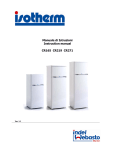
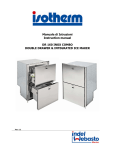
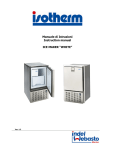


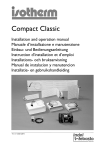
![[ES] Smart Energy Control Manual de Instrucciones y de Uso](http://vs1.manualzilla.com/store/data/006255326_1-bcb3ba9c27cbad56c6ef2fe6103a1f45-150x150.png)
